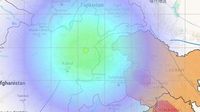A magnitude 5.9 earthquake struck Afghanistan's Hindu Kush region early Wednesday morning, sending tremors across northern India, including the Delhi-NCR area. The National Centre for Seismology (NCS) reported that the quake occurred at approximately 4:43 AM local time, with its epicenter located 164 kilometers east of Baghlan, a city with a population of around 108,000. The earthquake was recorded at a depth of 75 kilometers.
Initial reports from the European-Mediterranean Seismological Centre (EMSC) indicated a slightly lower magnitude of 5.6 and a greater depth of 121 kilometers. The discrepancy in reported magnitudes reflects the challenges of accurately measuring seismic events, especially in regions prone to tectonic activity.
Despite the quake's significant strength, no casualties or damage have been reported thus far. This is particularly notable given that a 5.9 magnitude earthquake is often strong enough to cause serious destruction, particularly near the epicenter. Social media was quickly abuzz with reports from residents in Delhi and neighboring areas, sharing their experiences of the tremors.
Earlier in the week, the region experienced heightened seismic activity, with a stronger 6.9 magnitude earthquake reported in Tajikistan. This series of tremors has raised concerns among seismologists and local authorities about the stability of the region, which has a history of significant seismic events.
On April 13, 2025, Tajikistan experienced a powerful 6.1 magnitude earthquake, followed by aftershocks, including a 3.9 magnitude quake shortly thereafter. The NCS reported these events, highlighting the ongoing seismic unrest in Central Asia. In addition, a 5.5 magnitude earthquake struck Meiktila city in Myanmar on the same day as the Tajikistan tremors, indicating a broader pattern of seismic activity affecting multiple countries in the region.
The recent earthquakes underscore the geological volatility of the Hindu Kush region, which is positioned at the convergence of several tectonic plates. This area is known for its susceptibility to earthquakes, with historical records showing numerous significant seismic events over the years.
In the aftermath of the 5.9 magnitude quake, emergency services and local authorities in Afghanistan are on alert, prepared to respond should any reports of damage or injuries arise. The Afghan government has been working to improve its disaster response capabilities, particularly in light of the country's vulnerability to natural disasters.
As of now, experts continue to monitor the situation closely, urging residents in affected areas to remain vigilant and prepared for potential aftershocks. The NCS and other seismic monitoring agencies are providing updates as new information becomes available, ensuring that the public is informed about ongoing seismic risks.
This earthquake serves as a reminder of the natural forces that shape our world and the importance of preparedness in regions prone to seismic activity. While the immediate impact of this event appears to be minimal, the broader implications for regional stability and safety remain a topic of concern for authorities and residents alike.
In conclusion, the 5.9 magnitude earthquake in Afghanistan's Hindu Kush region early Wednesday morning has prompted widespread tremors felt across northern India, though no immediate casualties or damage have been reported. As authorities continue to assess the situation, the focus remains on preparedness and safety in the face of ongoing seismic threats.





